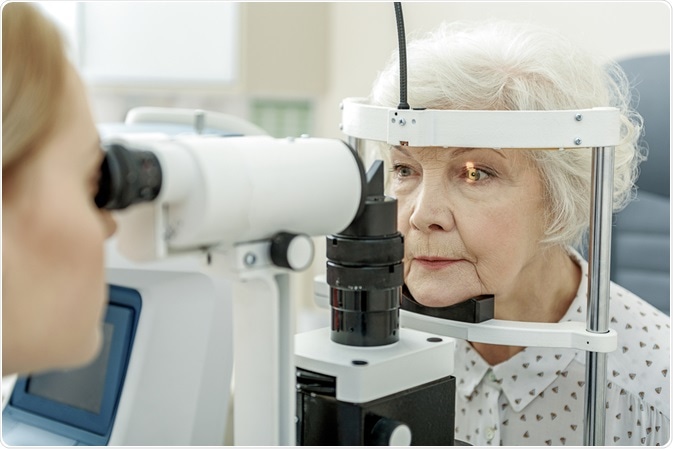Glaucoma is a common ocular condition whereby damage is caused to the optic nerve connecting the eye to the brain.

Image Credit: Olena Yakobchuk/Shutterstock.com
It is considered to be the second greatest factor causing permanent blindness in the US and typically affects aging adults.
Generally, glaucoma is referred to as an acquired loss of axons of the optic nerve and ganglion cells of the retina or optic neuropathy which leads to progressive vision loss. The condition can affect both eyes, yet, progression may differ between each eye, meaning glaucoma may be worse in one eye.
One of the main features of glaucoma is high intraocular pressure.
The eye’s anterior chamber which hosts the cornea, iris, lens, and pupil is filled by aqueous humor a clear, water-like fluid. This fluid helps nourish the lens and cornea by supplying them with vital nutrients and oxygen.
Other functions include providing the necessary pressure to maintain the eye’s shape, referred to as intraocular pressure (IOP). Glaucoma typically develops as a result of a blockage in the eye’s drainage tubes called the trabecular meshwork.
Due to the blockage, the aqueous humor is unable to flow, causing pressure to build up in the eye. This increased pressure subsequently damages the optic nerve and the retina’s nerve fibers.
Symptoms
Common symptoms of glaucoma include
- Blurry vision
- Headache
- Nausea and vomiting
- Severe eye pain
- Tenderness in the surrounding areas of the eye
- Reddening of the eye(s)
- Seeing halos around lights
Types of Glaucoma
There are several types of glaucoma such as primary open-angle glaucoma, congenital glaucoma, acute angle-closure glaucoma and secondary glaucoma. The most commonly diagnosed type in the UK and US is primary open-angle glaucoma.
Primary Open Angle Glaucoma
Individuals with primary open-angle glaucoma (POAG) often present as asymptomatic until the condition has progressed enough to damage the optic nerve severely. However, early signs may be noticed during routine eye tests. POAG is caused by buildup gradually causing a blockage further down the eye’s drainage channels.
Angle Closure Glaucoma
Unlike primary angle glaucoma, angle-closure glaucoma typically has a faster period of onset resulting in a rapid decline in vision. Associated indicative symptoms may be experienced, including feelings of nausea, vomiting, headaches, eye pain, and edema of the cornea.
Congenital Glaucoma
Congenital glaucoma or childhood glaucoma is a rare form of glaucoma that develops in young children as a result of the incorrect development of the eye’s drainage system.
Normal-tension Glaucoma
Individuals with normal-tension glaucoma suffer damage to their optic nerve despite a normal or low IOP. The cause of normal-tension glaucoma is still unknown but it is associated with a family history of the disease, Japanese ancestry or a history of systemic heart disease.
Secondary Glaucoma
Secondary glaucomas can be either angle-closure glaucoma or open-angle glaucoma. This category covers any glaucoma where there is an identifiable cause for the increase in IOP i.e. inflammation, diabetes, cataracts or the use of certain drugs like steroids.
An example of secondary glaucoma is pigmentary glaucoma that can be caused by laser eye surgery which can increase the release of pigment, debris, and inflammatory cells leading to the blockage of the drainage system ultimately increasing IOP.
Causes of Glaucoma
Glaucoma is generally caused by an evaluated IOP which subsequently damages the optic nerve. The mechanism in which this occurs is not currently well understood though. However, research has identified a series of risk factors that are considered to increase your likelihood of developing the condition. These include:
- Age: you’re more likely to develop glaucoma as you get older
- Family medical background: if a parent or sibling has also been diagnosed with glaucoma, you’re more likely also to develop the condition
- Ethnicity: individuals from Asian, African and Caribbean backgrounds are at more risk of developing glaucoma
- Eyesight issues such as long-sightedness and short-sightedness are associated with glaucoma alongside medical conditions such as diabetes
How is Glaucoma Diagnosed?
Adults and children are recommended to have routine eye tests, which can detect the early signs of glaucoma. Vision tests and the measurement of your eye’s internal pressures are often used by an optometrist to check for glaucoma.
If the test results are indicative of glaucoma, then a referral to an ophthalmologist is often made.
As there are no current guidelines on preventing glaucoma, most suggest having regular eye tests in order to detect the condition as early as possible to prevent rapid progression.
Treatments of Glaucoma
The majority of treatments for glaucoma aim to prevent further damage or loss of vision. Treatment options prescribed vary depending on the type of glaucoma. Surgery may be recommended to increase drainage of aqueous humor and reduce IOP.
Alternatively, laser treatments can be used unblock the tube or limit the amount of fluid produced, or eye drops may prove useful in reducing the IOP.
Updated 12th March by Chloe Bennett.
Sources
- NHS (2018). Glaucoma: Overview. https://www.nhs.uk/conditions/glaucoma/
- Glaucoma Research Foundation: Types of Glaucoma. https://www.glaucoma.org/glaucoma/types-of-glaucoma.php
- Dietze, J., Blair, K., & Havens, S. J. (2019). Glaucoma. StatPearls. https://www.ncbi.nlm.nih.gov/books/NBK538217/
- Goel, M., Picciani, R. G., Lee, R. K., & Bhattacharya, S. K. (2010). Aqueous Humor Dynamics: A Review. The Open Ophthalmology Journal. DOI: 10.2174/1874364101004010052
Further Reading